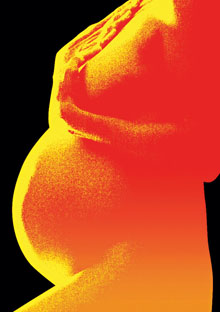The Blood Test Women Need—and Doctors Skip

Illustration: Sean McCabe
Ann Williams's three children each weighed more than nine pounds at birth—an indication that a mother's blood sugar may be high. She'd also had pregnancy-onset diabetes with her youngest. These were warning signs that she was at risk for type 2 diabetes, but her family doctor never followed up, she claims. "Years later I started feeling exhausted and insatiably hungry, so I checked my blood sugar at the office," says Williams, a registered nurse from Cleveland. "I diagnosed my own type 2 diabetes."
Clear Risk
The surest sign that a woman could develop diabetes is high blood sugar during pregnancy—gestational diabetes (GD)—but one study suggests that most women with this risk factor aren't tested. "GD indicates a woman has a propensity for insulin resistance. GD usually goes away after delivery, but your odds for developing full-blown diabetes can rise 50 to 70 percent," says lead researcher Michelle A. Russell, MD, of the Department of Veterans Affairs Medical Center in White River Junction, Vermont.
If you've had GD, your doctor should test your blood sugar at least six weeks after delivery and, if it's normal, every three years after that, according to the American Diabetes Association. But when Russell and colleagues tracked 344 women with GD, she found that less than half were checked at their postpartum visit. Among those who were, 28 percent already had above normal blood sugar and another 8 percent had scores that indicated diabetes.
"You can delay diabetes with diet and exercise, but women are more motivated to take those steps if they know they're at risk," Russell says. "You need to know—even if it means asking your doctor for a blood test."
Clear Risk
The surest sign that a woman could develop diabetes is high blood sugar during pregnancy—gestational diabetes (GD)—but one study suggests that most women with this risk factor aren't tested. "GD indicates a woman has a propensity for insulin resistance. GD usually goes away after delivery, but your odds for developing full-blown diabetes can rise 50 to 70 percent," says lead researcher Michelle A. Russell, MD, of the Department of Veterans Affairs Medical Center in White River Junction, Vermont.
If you've had GD, your doctor should test your blood sugar at least six weeks after delivery and, if it's normal, every three years after that, according to the American Diabetes Association. But when Russell and colleagues tracked 344 women with GD, she found that less than half were checked at their postpartum visit. Among those who were, 28 percent already had above normal blood sugar and another 8 percent had scores that indicated diabetes.
"You can delay diabetes with diet and exercise, but women are more motivated to take those steps if they know they're at risk," Russell says. "You need to know—even if it means asking your doctor for a blood test."
As a reminder, always consult your doctor for medical advice and treatment before starting any program.



